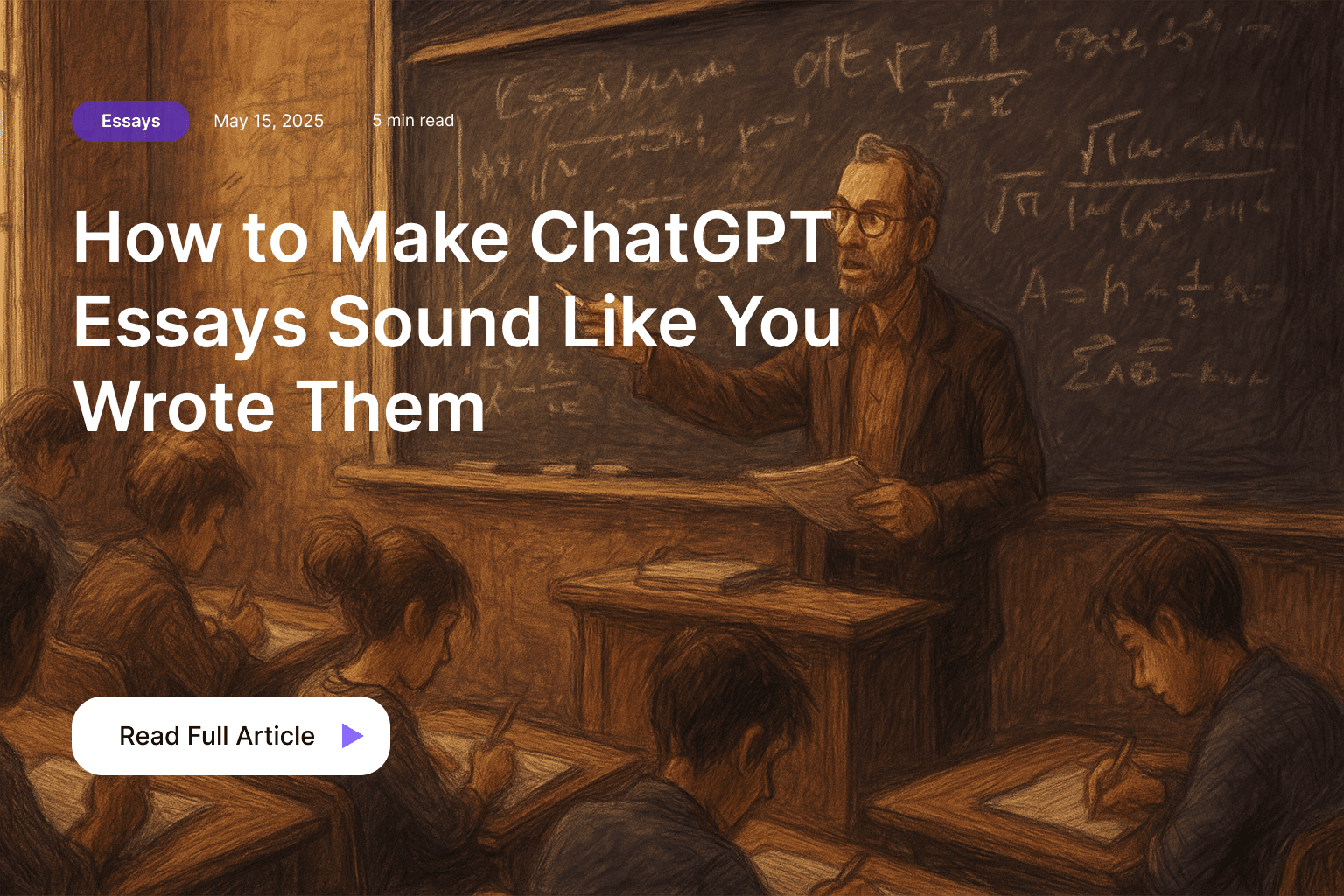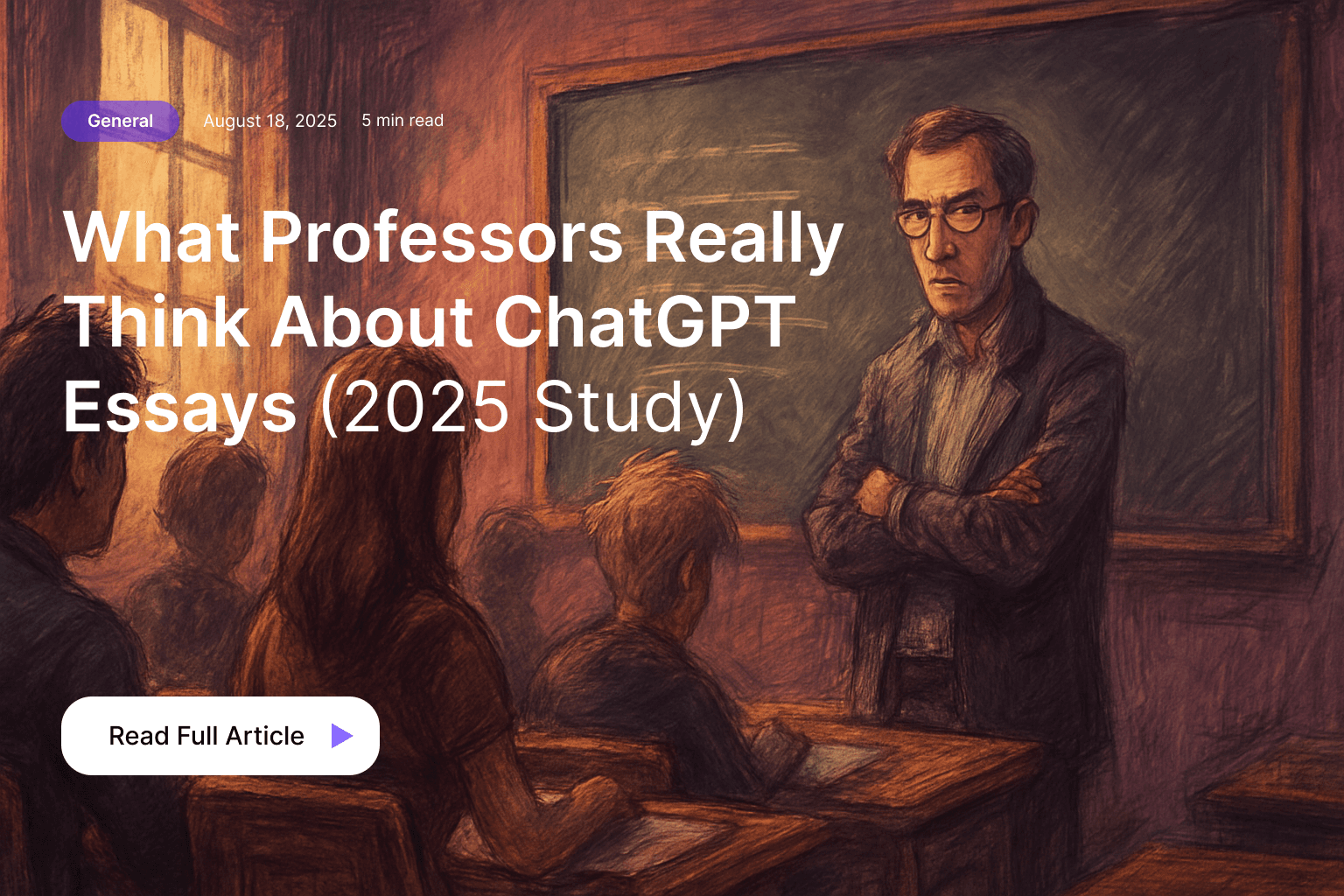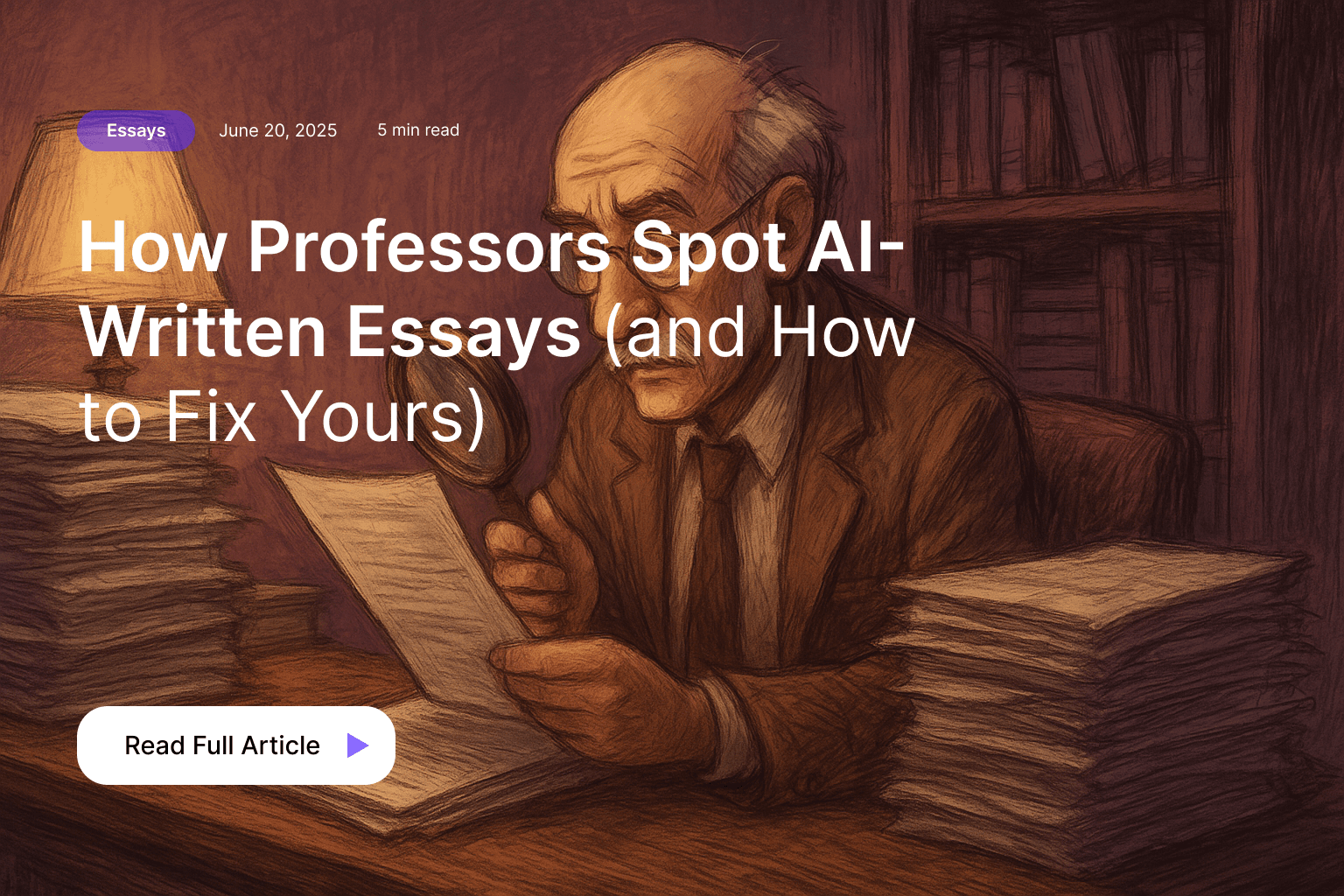Let’s be real, ChatGPT has quietly become every student’s last-minute group partner. You give it your essay prompt, it spits out a passable draft in 20 seconds, and suddenly that impossible 2,000-word paper doesn’t feel so impossible anymore.
But there’s a problem.
When you read it again, it doesn’t sound like you.
The vocabulary is too formal, the rhythm too clean, and the phrasing too “AI-ish.”
If you submit it as is, your professor might not need an AI detector, they’ll just feel something’s off.
The truth is: using ChatGPT isn’t the issue.
Submitting it unrewritten is.
So let’s fix that. Here’s how to make ChatGPT essays sound like you actually wrote them, real, fluent, and original, without losing the clarity that made AI helpful in the first place.
1. Understand what makes AI essays easy to spot
AI-generated essays have a distinct fingerprint. You can’t always see it, but professors can hear it when they read.
Here’s what gives them away:
a) The “machine rhythm”
Every sentence is perfectly medium length.
There are no short bursts, no natural pauses, no slight messiness that humans naturally produce. It’s like someone talking in a monotone - technically correct, emotionally flat.
b) Predictable transitions
AI loves connectors: “Furthermore,” “In conclusion,” “On the other hand.”
They’re everywhere. They don’t feel earned; they feel inserted.
c) The lack of lived texture
AI can explain, summarize, and even compare, but it can’t notice.
A human writer says, “When I first read this theory, it confused me.”
AI says, “This theory is significant in many ways.” See the difference? One sounds lived-in; the other sounds like a textbook.
d) The “too balanced” vocabulary
Every paragraph uses the same sentence pattern and word difficulty. Professors read hundreds of student papers a semester, they can immediately sense when something doesn’t match your past writing tone.
2. Why rewriting matters more than generating
You don’t have to stop using ChatGPT. You just have to stop copy-pasting it.
ChatGPT is great for creating structure, flow, and argument scaffolding. But your essay still needs the one thing AI can’t fake: your voice.
Rewriting isn’t cheating. It’s authorship.
You’re taking an AI-generated outline and turning it into your expression, your rhythm, your reasoning, your clarity.
That’s exactly what tools like Essaytone’s AI-to-Human Rewriter are built for. They keep the logic, but fix the tone: robotic → natural, stiff → readable, generic → real.
How to rewrite ChatGPT essays so they sound human
Here’s a five-step process to transform any AI-generated essay into a natural, original piece that sounds unmistakably like you.
Step 1: Start with your own structure
Before rewriting, copy ChatGPT’s draft into sections - introduction, argument 1, argument 2, conclusion. Don’t edit yet; just separate the flow.
You’ll notice it follows a perfect textbook logic. That’s fine. Structure is the one part AI is good at.
Step 2: Add your reasoning between the lines
AI explains “what.” Humans explain “why.”
Between each major point, add one line where you connect the idea to your understanding, your class, or your opinion.
Example:
AI version: “Social media influences how young people form their political opinions.”
Human rewrite: “From what I’ve seen on campus, political opinions often form in group chats long before students engage in actual debates.”
Suddenly, it sounds like a person wrote it, because one did.
Step 3: Rewrite every sentence for flow
This is where you use a rewriting tool like Essaytone. Paste each section and let it rewrite robotic phrasing into academic-sounding natural prose.
The goal isn’t to trick AI detectors, it’s to regain your rhythm.
For example:
AI draft: “Technology has influenced education in significant ways across history.”
Rewritten: “Technology has reshaped how we learn — from chalkboards to AI tutors - each wave changing what students expect from education.”
You’re saying the same thing, but with movement and tone.
Step 4: Break the pattern
If every paragraph starts the same way, your professor will notice. Add one sentence fragments for emphasis, or mix lengths.
Instead of:
“Furthermore, it is also important to note that environmental concerns continue to grow.”
Try:
“And it’s not slowing down. Environmental concerns keep rising - faster than most governments can react.”
Short. Real. Confident.
Step 5: Read it out loud
If it flows like spoken thought, it’s human.
If it sounds like you’re narrating a Wikipedia entry, it’s AI.
Reading out loud exposes robotic phrasing instantly.
4. Example: ChatGPT vs. rewritten essay
Let’s see the difference in action.
Prompt: “Explain how globalization impacts cultural identity.”
ChatGPT Draft:
“Globalization has significantly influenced cultural identity around the world. As countries become more interconnected, cultural boundaries are blurred, leading to both positive and negative outcomes. Some argue that globalization leads to cultural homogenization, while others believe it promotes diversity.”
Now, rewritten to sound human:
Human Rewrite (via Essaytone):
“Globalization has changed what it means to belong. As cultures mix through media and migration, traditions evolve, sometimes beautifully, sometimes at a loss. For many, this connection feels liberating. For others, it feels like something familiar is fading.”
The ideas are the same. The voice isn’t.
That’s what rewriting does.
5. Use AI like a co-writer, not a ghostwriter
The best writers of this decade aren’t the ones avoiding AI — they’re the ones directing it.
You can treat ChatGPT as your outline generator, research assistant, or sentence tester. But once it gives you text, your job is to rewrite for clarity, emotion, and authenticity.
Here’s a good workflow:
| Stage | Tool | Goal |
|---|---|---|
| Brainstorming | ChatGPT | Generate ideas, outline |
| Drafting | ChatGPT + you | Fill in structure |
| Rewriting | Essaytone | Humanize tone, improve clarity |
| Editing | You | Add personal insight and nuance |
6. Common mistakes to avoid when rewriting AI essays
If you’re rewriting for the first time, watch out for these traps:
❌ Over-editing.
Don’t make it too “fancy.” Simplicity sounds human.
❌ Copy-pasting synonyms.
That’s not rewriting; that’s camouflage.
AI detectors can still flag those patterns.
❌ Mixing voices.
Don’t rewrite only the first half, your tone should stay consistent throughout.
❌ Forgetting to proofread.
Even rewritten text can have awkward transitions. Read once after AI assistance.
7. The ethical side: using AI responsibly
Using ChatGPT to help you write doesn’t make you lazy.
Using it to replace your thinking does.
Rewriting ensures you still understand and own your argument. That’s the difference between assistance and dishonesty.
Think of it like a calculator in math, it helps you do the work faster, but you still have to understand the equation.
If your rewritten essay reflects your understanding and voice, it’s your work. You’ve simply used technology to polish it.
8. The mindset shift: from “AI user” to “AI editor”
The future of writing isn’t about hiding AI but about editing it.
Your generation will be the first to treat AI like a creative tool, not a threat. That means learning to rewrite, refine, and reclaim your tone from the machine.
When your essay sounds natural, your professor doesn’t think “AI.”
They think, “This student knows how to write clearly.”
And that’s the win.
9. Why Essaytone exists
At Essaytone, we’ve seen millions of AI drafts, from undergraduate essays to PhD theses, and they all share the same issue: they sound synthetic.
So we built a rewriting engine that does one thing exceptionally well, turn robotic AI text into clear, human academic writing.
You paste. It rewrites. You edit. Done.
The result? Essays that sound like you.
AI isn’t the problem, it’s the starting point.
What separates an average student from a great one isn’t whether they used ChatGPT.
It’s whether they rewrote it into something real.
Next time you generate a draft, don’t panic about sounding “too AI.”
Just open Essaytone, rewrite it naturally, and make your work feel authentically yours again. Because the goal isn’t to hide your AI use but to show your voice.




